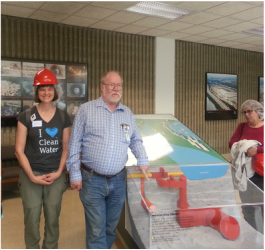 LWVLMR Hank with MWRD Hank, and a model of Deep Tunnel LWVLMR Hank with MWRD Hank, and a model of Deep Tunnel Triple Play –One: The Stickney Water Treatment Plant Thirty guests from Illinois, Indiana and Michigan came with the LWV Lake Michigan Region on June 26 to the Stickney Water Treatment Plant, the largest wastewater treatment facility in the world. This Plant serves 2.38 million people in a 260 square mile area including the central part of Chicago and 43 suburban communities. MWRD has other smaller plants, as well, to serve the rest of their jurisdiction. The Stickney Plant has a design capacity of 1,200 million gallons per day. When wastewater enters the plant, the first phase physically removes contaminants, either large non-biological items or sand and grit. These materials are dumped in a sanitary landfill after being washed. The water then flows into a primary settling tank where revolving skimmers continually collect the solid waste at the bottom and the oily film on the top. The second phase employs a large population of micro-organisms in a series of tanks. These bacteria feast upon the remaining biological compounds and convert the waste into a form that's easier to separate from the water. The first tanks are aerated to provide sufficient oxygen for the microbes to grow, eat and multiply. The second tank separates the bacteria culture from the treated water. “Keeping the bacteria happy” is a primary job for plant engineers, who attest that these organisms do lots of work for us for free. Treated water is either discharged to the Sanitary and Ship Canal (and onward to the Illinois, then the Mississippi Rivers), or else it goes to a third stage of cleaning to remove the last 5% of contaminants, which can include the nutrients that cause algae blooms. Not all the water goes through this stage due to lack of capacity – but there is a large nutrient recovery facility under construction, which we saw. Right now, the entire cleaning process takes a bit less than 12 hours. Triple Play –Two: A bus tour of LASMA (Lawndale Avenue Solids Management Area) What to do with all of that sludge that was mechanically removed at the Stickney plant? It is sent by rail to LASMA, where it is centrifugally separated from any remaining water, then dried in large outdoor beds and ultimately hauled off to be recycled. Golf courses, sod farms, street medians and park districts all use these bio-solids as fertilizer. Triple Play –Three: Inside the Deep Tunnel Mainstream Pumping Station Construction of Tunnel and Reservoir Plan (TARP) began in 1975 and the first phases were operational in 1985 but the whole system will not be finished completely until 2029. Phase I includes 109.4 miles of deep, large diameter, tunnels down in the bedrock which provide 2.3 billion gallons of volume. Phase II of TARP, the reservoirs, were intended primarily for flood control. When the Stickney plant reaches capacity during heavy storms, excess water now goes into Deep Tunnel. When the tunnel is filled, water can overflow into the waters of Cook County at numerous points for CSOs, and/or can go to the reservoirs. Reservoirs are not fully functional yet but do increase storage capacity and thus reduce the need for CSOs in the rivers, or the even more drastic need that occurs from time to time – to open locks in Chicago or Wilmette which send untreated storm and wastewater into Lake Michigan. When storms abate and the Stickney plant can handle it, water held in deep tunnel and the reservoirs is pumped up to the plant for treatment. LWVLMR tries to keep tabs on the MWRD as it is a huge government agency which has impact on our Lake, drinking water, stormwater management and pollution in multiple watersheds. We are always looking for area-volunteers who wish to be observers of their meetings. Please contact LWVLakeMichigan@gmail.com if you are interested in helping with this important work. |
Archives
December 2017
Categories
All
|

 RSS Feed
RSS Feed